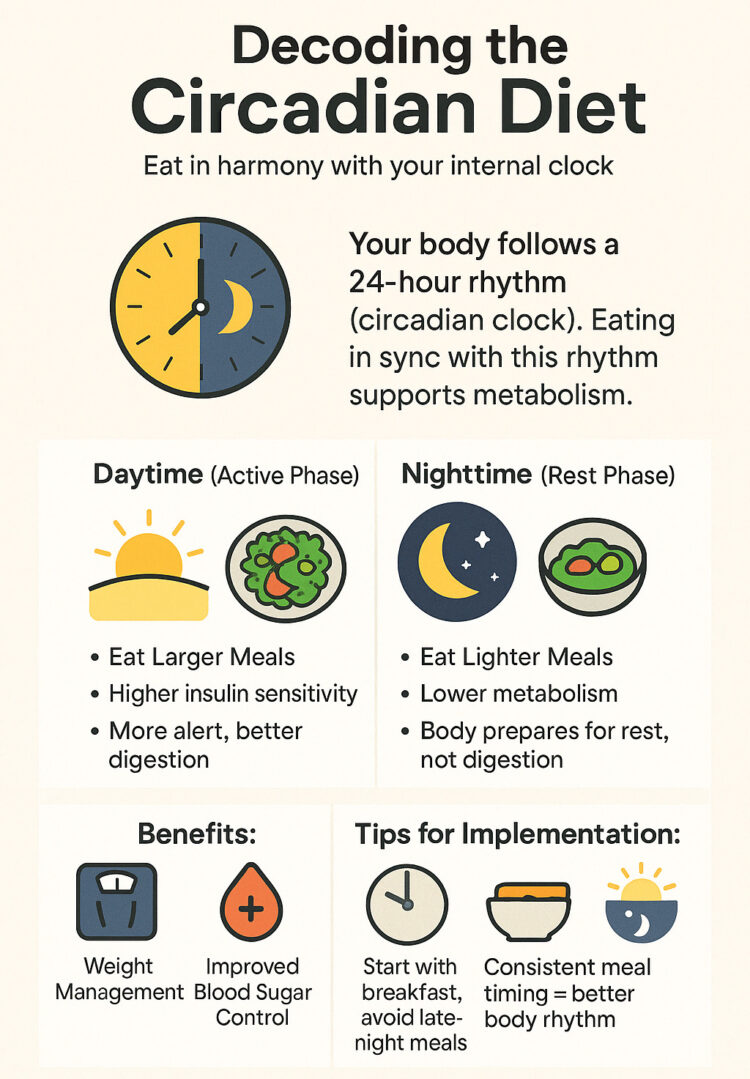Obesity is one of the biggest health issues in the US, as most people think that weight loss is complicated.
Mainstream diets are complicated, restrictive, and cause lifestyle friction. However, there is a much simpler and sustainable way to achieve your fat loss goals.
Enter the circadian diet.
The core principle of this diet is remarkably straightforward — align your eating patterns with your internal 24-hour clock and the sun’s cycle.
In this article, I explain how switching to the circadian diet can help you optimize your metabolism and achieve your fat loss goals in 2025. I’ll also share tips on how to adopt it according to your unique lifestyle.
Decoding the Circadian Diet
While many people have heard of the circadian rhythm, only a few know about chrononutrition. It explores how timing your meals affects your health, metabolism, and overall well-being and emphasizes aligning your food intake with your body’s natural biological rhythms to optimize metabolism.
Level Up Your Fitness: Join our 💪 strong community in Fitness Volt Newsletter. Get daily inspiration, expert-backed workouts, nutrition tips, the latest in strength sports, and the support you need to reach your goals. Subscribe for free!
Chrononutrition, often called the ‘circadian diet,’ centers around consuming most of your daily calories during the daylight hours and significantly minimizing, or even eliminating, food intake as the evening approaches.
Think of it as aligning your eating patterns with the natural rhythm of the sun.
As you might have guessed, the rationale behind this approach is to sync your food intake with your body’s natural metabolic peaks and valleys.
Typical Circadian Eating Window
The exact circadian eating window will vary for each individual depending on their geographical location and the sunrise to sunset schedule. It also has to be updated with respect to the weather and change in daylight timings.
Nonetheless, this usually translates to a 10-12 hour eating period during the day in summer. For instance, if the sun rises around 6 AM and sets around 6 PM, your eating window will roughly be the same.
Departure from Traditional Eating Patterns
Many people have a light breakfast, or skip it entirely, consume a moderate lunch, and then have their largest meal in the evening.
The circadian diet encourages you to front-load your calories earlier in the day when your metabolism is more active. Plus, you’ll eat less as the day progresses and might even skip dinner.
Like intermittent fasting, the circadian diet is primarily about when you eat rather than what you eat. You are not necessarily restricted from eating specific food groups, but you should consume the bulk of your calories during daylight hours.
That said, you should focus on getting most of your calories from nutrient-dense whole foods to make the most of this diet.
I like to think of the circadian diet as a Paleolithic and intermittent fasting diet hybrid. We are basically trying to emulate the eating patterns of our ancestors, who typically ate during the day when they were active and food was accessible. They stopped eating at night.
Practical Strategies for Embracing the Circadian Diet in 2025
Here are six practical tips to implement the circadian diet in your routine:
1. Front-Load Your Calories
This is a cornerstone of the circadian diet.
By consuming the majority of your daily calories earlier in the day — focusing on breakfast and lunch — you are providing your body with all the energy it needs to function optimally and maximize productivity.
I recommend starting with a substantial breakfast, comprising an ample amount of protein and fiber to keep you feeling full and energized. Eggs with vegetables, Greek yogurt with berries and nuts, or whole-grain oatmeal with protein powder are a great place to start.
Coach Tip: Use this convenient total daily energy expenditure (TDEE) calculator to determine your ideal calorie and macronutrient intake goals.
Furthermore, lunch should be the biggest meal of your day and should include a lean protein with a generous serving of vegetables and complex carbohydrates like sweet potato or quinoa. Making lunch your largest meal makes the most sense as it is when most people are the most active.
Scale back your calories as the day progresses to allow your body time to process all the food you have consumed throughout the day.
Contrary to what most people think, the circadian diet does not mean you should starve yourself. You must make smart food choices to ensure you have enough fuel in your system to prevent cravings.
2. Stay Hydrated
The human body is 75 percent water, and staying adequately hydrated is essential for overall health and well-being. It can also support your fat loss efforts, as drinking water can lead to satiety and play a crucial role in numerous metabolic processes.
Aim to drink at least a gallon of plain water daily. Instead of gulping down most of it early in the morning, spread your water consumption evenly throughout the day to limit the risk of dehydration.
I recommend drinking water or herbal tea if you experience late-night hunger pangs. Also, you could engage in relaxing physical activities to take your mind off food.
Level Up Your Fitness: Join our 💪 strong community in Fitness Volt Newsletter. Get daily inspiration, expert-backed workouts, nutrition tips, the latest in strength sports, and the support you need to reach your goals. Subscribe for free!
3. Time Your Meals with Natural Light
There is no better way to fine-tune your body’s circadian rhythm than timing your meals with sunlight. Doing this reinforces your body’s internal clock and optimizes metabolism.
Experts recommend starting eating within an hour or two of sunrise and wrapping up your last meal a few hours before sunset.
This sounds easier said than done. If your schedule doesn’t align perfectly with the sun, aim for a consistent 10-12 hour eating window during daylight hours.
4. Keep Dinner Light and Early
Our bodies naturally start to wind down as evening approaches, meaning we do not need as much food as in the morning. Consuming a large, heavy dinner close to bedtime can disrupt your sleep, impairing digestion and negatively impacting sleep quality. This can throw a wrench in your fat-loss efforts.
Eat the day’s final meal before sunset and opt for easily digestible foods like fish or chicken with steamed vegetables. Keep the portion size small to avoid burdening your stomach.
5. Establish a Consistent Eating Window
As with any other diet routine, consistency is key for achieving your goals with the circadian diet. You cannot improve your metabolism meaningfully by tweaking your meal timings a few days each week.
Select an eating window that suits your lifestyle, even on the weekends. Aim to get all your calories from healthy sources once you have perfected your eating window.
6. Other Tips
Healthy fats, when consumed in moderation, do not lead to body fat accumulation. Avocados, nuts, and seeds should be a staple in your diet as they can keep you feeling full for longer. Consume a wide variety of foods in your breakfast and lunch to keep your diet exciting and prevent nutrient deficiencies.
Plus, eliminate sugary cereals and processed foods from your diet, as they can cause energy crashes and mess up your metabolism.
Understanding Circadian Rhythms
Our energy levels fluctuate throughout the day due to our body’s internal clock. This impacts our physical performance and overnight recovery, which are incredibly important for muscle repair and fat loss.
The body’s internal 24-hour clock is known as the circadian rhythm and dictates when you wake up, feel alert, wind down for sleep, and get hungry. It also affects body temperature, digestion, metabolism, and physical and cognitive performance.
How Circadian Rhythms Influence Metabolism
This is how it impacts your health:
Causes Metabolic Dysfunction
Your body handles nutrients differently at various times of the day, aligning with its natural activity and rest cycles. Your body’s ability to regulate blood sugar and process fats can suffer when its internal clock is off. This can lead to insulin resistance, a major hurdle in shedding body fat. (1)
Coach Tip: It’s not just about what you eat but also when you eat it.
Results in Fluctuating Insulin Sensitivity and Glucose Tolerance
A big morning meal can make you feel energized, but the same meal can make you feel sloppy at night. The difference arises from how your body handles glucose — the primary energy source.
Typically, your insulin sensitivity and glucose tolerance peak in the morning, allowing your body to shuttle glucose from your bloodstream into your cells for energy or storage.
As the day progresses, your body’s efficiency at carrying out this process declines significantly. This means that a late-night carbohydrate-heavy meal is more likely to be stored as fat instead of being used as fuel for quick energy release.
Leads To Hormonal Imbalances
A disrupted circadian rhythm puts you at a risk of weight gain and obesity due to hormonal imbalances that increase appetite and cravings.
Your ghrelin (hunger hormone) levels typically rise before meals and fall after you have eaten. Leptin, on the other hand, signals fullness to your brain. Leptin levels are usually higher after you’ve eaten, helping you feel satisfied after a meal.
However, circadian rhythm disruption can interfere with these hormone balances, leading to increased hunger and overeating, especially during the wee hours.
Consequences of a Poor Internal Clock
Eating at the wrong times can clash with your natural circadian rhythm, disrupting your metabolism, leading to higher blood sugar levels, and an increased risk of insulin resistance.
This doesn’t end here; when your circadian rhythm is off, your body isn’t efficient at processing nutrients, particularly carbohydrates and fats. These are more likely to be stored as adipose fat tissue, which is more difficult to lose.
Research suggests that eating at awkward times can lower your overall daily calorie expenditure, making your body hold onto excess fat. (2)
Overcoming Challenges with the Circadian Diet
Below are the most common issues that you might face with this diet:
- Late-night snacking: Close the kitchen for the night after sunset, and avoid eating anything late at night as it contradicts your body’s natural circadian rhythm.
- Shift work: People working a night shift might find aligning their meals with the sun tricky. The key here would be to establish a consistent eating window that aligns with your active period, even if it’s during the night.
- Social events: Most gatherings and celebrations revolve around food and are usually in the evenings. You shouldn’t stress too much about sticking to your eating window if you go out once a month. Enjoy yourself, but stick to your regular schedule for the rest of the month.
Remember, these are just guidelines. You must learn to listen to your body. Pay close attention to your hunger and fullness cues within your established eating window and adjust it accordingly.
Conclusion
The circadian diet is a potent tool that can help you achieve your weight loss objectives in 2025.
You don’t have to make all these changes overnight. Start small, make the habits a part of your lifestyle, and add to them as your body adapts. Best of luck!
References:
- Verkouter I, Noordam R, le Cessie S, van Dam RM, Lamb HJ, Rosendaal FR, van Heemst D, de Mutsert R. The Association between Adult Weight Gain and Insulin Resistance at Middle Age: Mediation by Visceral Fat and Liver Fat. J Clin Med. 2019 Sep 28;8(10):1559. doi: 10.3390/jcm8101559. PMID: 31569345; PMCID: PMC6832997.
- Ruddick-Collins LC, Morgan PJ, Fyfe CL, Filipe JAN, Horgan GW, Westerterp KR, Johnston JD, Johnstone AM. Timing of daily calorie loading affects appetite and hunger responses without changes in energy metabolism in healthy subjects with obesity. Cell Metab. 2022 Oct 4;34(10):1472-1485.e6. doi: 10.1016/j.cmet.2022.08.001. Epub 2022 Sep 9. PMID: 36087576; PMCID: PMC9605877.













